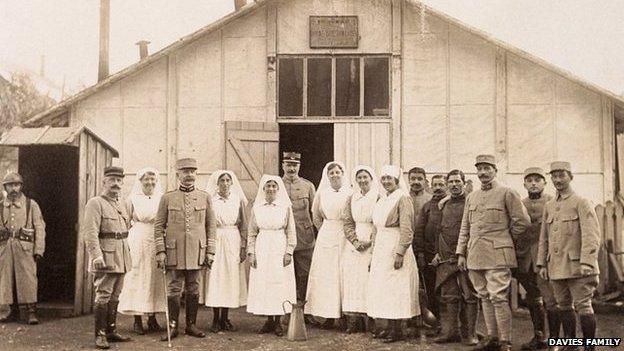Gwendoline and Margaret Davies' help for WW1 refugees
- Published

After the war ended, Gwendoline Davies wrote it had "broken her to pieces"
They are best known for amassing one of the great British art collections of the 20th Century, but less is known about the important role sisters Gwendoline and Margaret Davies played during World War One.
They are famous for bequeathing their art to the National Museum Wales, transforming its collection.
But during the war the sisters, who grew up in Llandinam, near Newtown, Powys, displayed another kind of generosity, helping artist refugees from Belgium.
"The idea was instilled in them by their grandfather that as Calvinistic Methodists they should be great philanthropists, they should do something for their country," said their biographer and TV presenter Trevor Fishlock.
In 1914 when Germany invaded Belgium, more than a million Belgians fled their homes and about 100,000 came to Britain seeking refuge.
'Raise the standard'
Mary Oldham, the librarian at Gregynog Hall which the sisters bought after the war, said helping refugees was their "first great project".
"Gwendoline and Margaret, along with their brother David, rushed to help", she said.
A number of Belgian artists and their families were helped to move to Wales, including sculptor George Minnie and painters Valerius de Saedeleer and Gustave van de Woestyne.
As well as helping, Mary Oldham said the sisters also had another motive.
"They thought it they could encourage artists to come and settle in Wales it would be a great boost to the creative arts here," she said.
"It would allow students in Wales to work with very distinguished artists from Belgium and help raise the standard of arts and crafts here."
Valerius de Saedeleer and his family, including five daughters, set up home in Ty'n Lon on the outskirts of Aberystwyth in Rhydyfelin.
Charlotte Dubenskij reports
Current owner Anthony Evans has researched the history of the house.
"De Saedeleer was employed by the arts and crafts department at Aberystwyth University which had been newly formed by the Davies sisters", he said.
But the family only lived in the area for four years.
Mr Evans said: "De Saedeleer had been led to believe he would be given one of the top jobs in the art department when it had a chair, but this didn't happen."
Though the sisters dug deep into their pockets to help the Belgian artists and their families, Mr Fishlock said they "very badly wanted to go to the war, even though it was often dangerous and miserable, they wanted to serve and help others".
'Soup and snacks'
"Their brother had fought in the trenches and their cousin had been killed during the fighting," he said.
"They were also French speaking and they loved France, so it was natural in a way that they should go the French Red Cross and set up a canteen."
The canteen, about 60 miles (96km) south-east of Paris in Troyes, was for French soldiers who were either on their way to fight or returning home from war, badly in need of refreshment and comfort.
"The soldiers in their blue uniforms paused for the coffee, soup and snacks the sisters and their helpers provided", he said.
He said the sisters saw a great deal of destruction in France and many men who were wounded dying.
"Gwendoline wrote after the war had finished that 'the war had broken her to pieces,'" he added.
However, while in France the sisters also found time to pursue their love of art.
"Gwendoline occasionally took the train to Paris and went to a gallery she knew well and bought good art, great art", said Mr Fishlock, whose book is entitled A Gift of Sunlight.
During this period she bought two celebrated landscapes by Cézanne.
The works were later bequeathed to the Cardiff museum, with more than 250 works by artists like Van Gogh, Monet, Renoir and Rodin.
- Published20 June 2013
- Published7 July 2011